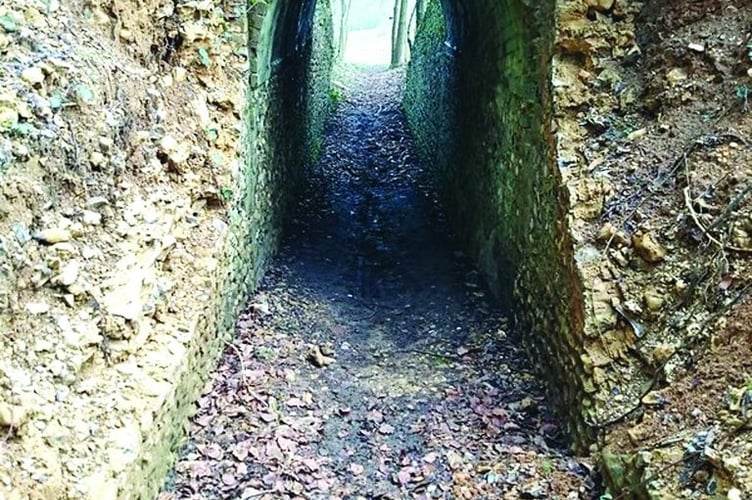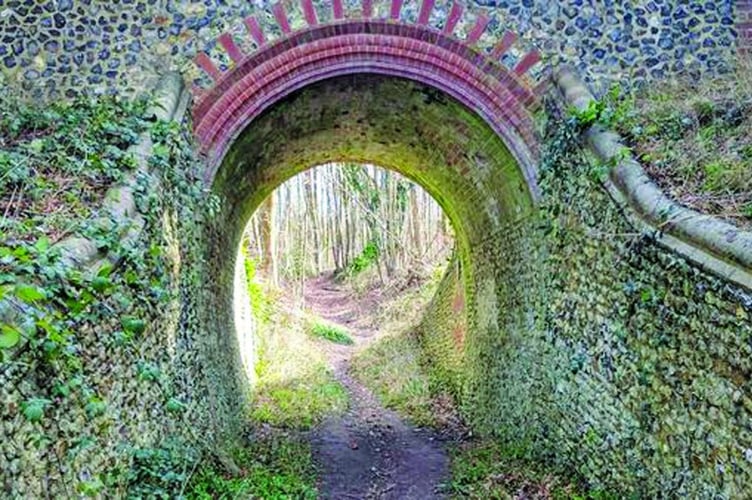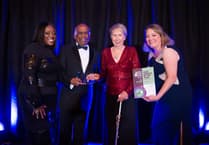SURREY’S countryside is excellent walking territory, and you can encounter many oddities on a stroll in the county. Some of the strangest to be found are the tunnel-like bridges around East Horsley.
Each has been individually designed and uniquely decorated – and they are deep in the woods, to be found on a rural adventure.
The same decorative brick and flint style is also evident in properties all over the East Horsley area. It’s known as the Lovelace style – named after the 1st Earl of Lovelace (1805-1893), who owned the Horsley Towers mansion and much of the surrounding countryside.
Lovelace, who was known as the Hon. William King until 1833 and as the Lord King from 1833 to 1838, was very enthusiastic about architecture and forestry. He was made Lord-Lieutenant of Surrey in 1840 and bought the East Horsley Estate at about that time.

His architectural signature is stamped across the surrounding area, from his magnificent home in Horsley Towers to humble estate workers’ cottages. He rebuilt most of the village of East Horsley with about 50 of his characteristic buildings. Horsley Towers itself is now a hotel, conference centre and wedding venue.
Lovelace ran a commercial timber business and enjoyed riding in his woodlands and that led to the bridges being constructed. To simplify moving the timber to the sawmill and riding around the estate, he embarked on a programme of bridge building in the 1860s. His bridges were built where the tracks crossed existing bridleways or roads.
Altogether, Lovelace designed and built 15 horseshoe-shaped bridges, ranging in size from about 6ft wide at Meadow Platt to 18ft at Dorking Arch, which crosses the road leading to Ranmore Common. They all mirrored the ornate style of the other buildings on the estate.
The earl had his own brickworks and the lime for the mortar would have been sourced locally.
Over the years many of the bridges – now known collectively as the Lovelace Bridges – became unsafe and even derelict, and some have been pulled down.
Ten remain: Stony Dene, Dorking Arch, Briary Hill East, Briary Hill West and Raven are owned by Forest Enterprises, while Outdowns, Meadow Platt, Hermitage, Troy and Robin Hood are in private ownership.

Horsley Countryside Preservation Society, with the aid of grant money, has embarked on a conservation programme instigated by a local man Peter Hattersley, beginning with Stony Dene. Its arch boasts smart new decorative brick detail and a stabilised structure.
Although each was built to a unique design, the style is similar, using flint and red brick. Only three have retained their name and date plaques: Oldlands, Stony Dene and Robin Hood.
If you’ve walking in the East Horsley area and fancy spotting some of the bridges, an online map sheet prepared by the preservation society is invaluable. It includes the many tracks and rights of way through the woods, as well as a suitable car park and the defined Lovelace Bridges Trail. You can download the printable sheet at http://bit.ly/1LTrUct.
Alternatively, the website Fetch Everyone has a route taking in all the surviving bridges and the sites of those demolished. Visit www.fetcheveryone.com/route-1736251.




